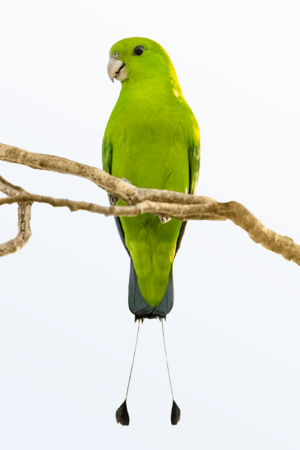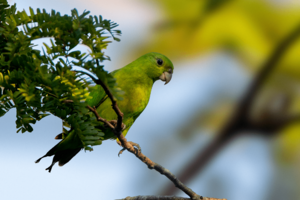Green racket-tail facts for kids
Quick facts for kids Green racket-tail |
|
|---|---|
 |
|
| Conservation status | |
| Scientific classification | |
| Genus: |
Prioniturus
|
| Species: |
luconensis
|
The green racket-tail (Prioniturus luconensis) is a special type of parrot that lives only in the Philippines. You can find it on the islands of Luzon and Marinduque. This beautiful bird used to be common, but its numbers are now dropping very quickly. It is currently an endangered species. This is mainly because its forest home is being cut down and because people catch these birds to sell as pets.
Scientists believe there are only about 1,000 to 2,499 adult green racket-tails left. Their numbers keep going down, and they have even disappeared from many places where they used to live.
Contents
What Does the Green Racket-tail Look Like?
The green racket-tail is a medium-sized parrot. It has two special tail feathers in the middle. These feathers have long, bare shafts that end in a unique "racket" shape.
The bird is mostly green. Its back is a bit darker green, while its head and belly are lighter. It also has a pale beak. Male green racket-tails are usually more yellowish-green than females. Females are generally darker and less yellowish. Their bare tail shafts are also shorter. Young birds (juveniles) do not have the racket-shaped tails yet. The green racket-tail is about 29 centimeters (11 inches) long.
This parrot makes loud, ringing, metallic squawks. It lives in the same areas as the Luzon racket-tail and the Blue-naped parrot. However, the green racket-tail prefers lower elevations. It also does not have a brownish back like the Luzon racket-tail. Unlike the Blue-naped parrot, the green racket-tail has a pale beak, not a red one.
Like all other Racket-tail parrots, these birds make their nests inside holes or hollows in trees. This is why they are called "cavity nesters."
Where Does the Green Racket-tail Live?
Green racket-tails live in the tops of trees, known as the canopy, in tropical lowland rainforests. They can be found at elevations up to 700 meters (about 2,300 feet). They mostly prefer old, untouched forests, which are called primary forests. However, they can also be seen in forests that have grown back after being cut down, known as secondary forests. Sometimes, they even visit farms to eat crops.
Why is the Green Racket-tail in Danger?
The green racket-tail is listed as an Endangered species. This means it is at a very high risk of disappearing forever. As mentioned, there are only an estimated 1,000 to 2,499 individuals left. The bird is feared to have disappeared completely from Marinduque island.
The biggest threat to these parrots is being caught and sold as pets. This is called the "cage-bird trade." Another major problem is the loss of their forest homes. This happens because of:
- Logging: Trees are cut down for wood, both legally and illegally.
- Mining: Land is dug up to find minerals.
- Road construction: New roads are built through forests.
- Slash-and-burn farming: Forests are cut down and burned to clear land for farming. This is also known as kaingin.
For example, in 1988, only 3% of Marinduque island had forest cover left. On Luzon, only 24% of the forest remained. These remaining forests are still being threatened. Even in areas like Subic, which is a strong home for these birds, illegal logging and deforestation are increasing.
Sometimes, other bird species can also be a threat. The more common Blue-crowned racket-tail has taken over areas where the green racket-tail used to live, like in Quezon National Forest Park.
What's Being Done to Help?
The green racket-tail is found in two protected areas: Bataan National Park and the Northern Sierra Madre Natural Park. It also has some protection in the Maria Aurora Memorial Natural Park. However, in many parts of the Philippines, rules about protecting nature are not always strictly followed. This means deforestation and the illegal pet trade continue.
To help save the green racket-tail, here are some ideas:
- Find more homes: Look for other places where these birds live. Then, make these places protected areas.
- Learn more: Study how these birds live all year round. This will help us understand how to best protect them.
- Watch other birds: Keep an eye on other racket-tail species. This helps monitor if the Blue-crowned racket-tail is spreading too much.
- Stop illegal logging: Improve protection against illegal logging in places like Subic Bay Forest Reserve. Make sure that environmental checks are done before any new logging is allowed.
- Breed in captivity: Start a program to breed these parrots in zoos or special centers. This could help release them back into the wild later.
- Speak up: Argue against new building projects that might harm the bird's forest home.



